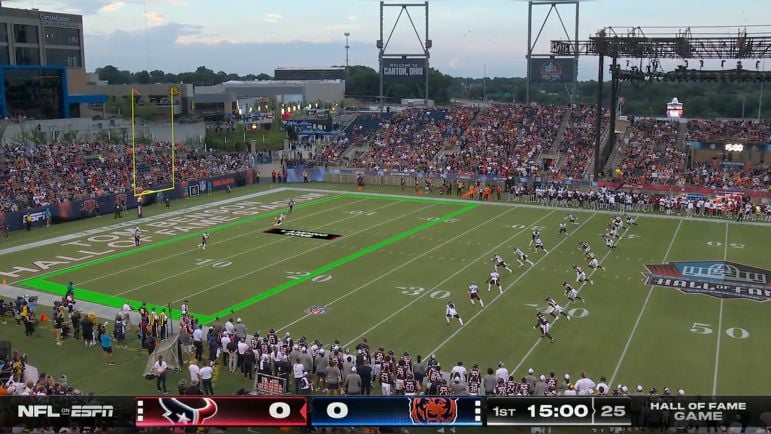The NFL world got its first look at the new kickoff rule during the Hall of Fame game between the Chicago Bears and Houston Texans on Thursday night. There were eight total kickoffs to look at in the game that was cut short by weather. Other than some sessions at training camp practice where the teams may or may not have been tackling to the ground, this was the first time in a live session running the new rule.
So what did we learn from these eight kickoffs, and what did it teach us about how this rule change might play out in the 2024 season?
For one, the return schemes were all very vanilla. Pittsburgh Steelers special teams coordinator Danny Smith predicted this during his post-practice interview on Thursday. Teams will use the preseason to drill the basics and the structure of the new rule before starting to implement more advanced return schemes.
For a high-level overview, seven of the eight kickoffs were returned, and just one was downed in the end zone for a touchback. Two of the plays had penalties, but both were on the receiving team and declined. So, in a (very) small sample size, 25 percent of the plays were penalized, and 12.5 percent were touchbacks. The average starting field position after the kickoff was the 26.13-yard line. The best starting field position was at the 32-yard line, and the worst was at the 20-yard line.
We will start with the last kickoff of the day first to show and explain the new touchback rule.
The new rule states that all kicks that land in the landing zone between the goal line and the 20-yard line must be returned. If a kick falls short of that zone, it is counted as out of bounds, and the ball is placed at the 40-yard line. If the kick lands in the landing zone, rolls into the end zone, and is downed for a touchback, then it is placed at the 20-yard line. What happened below is the third type of non-return, which is the ball going beyond the landing zone for a traditional touchback. This now gets placed at the 30-yard line.
The touchback was at the 20-yard line for a long time before changing to the 25 starting in 2016. The additional five yards on the traditional touchback is to incentivize teams to kick into the landing zone and have more returns.
On this play, the third kickoff of the game, the ball went beyond the landing zone. The Bears opted to return it anyway and had the worst return of the day to just the 20-yard line. They could have taken the extra 10 yards on a touchback. It could have just been a mental error, or the special teams coordinator instructed them to return those close ones to be safe and get more reps during the preseason. The touchback wouldn’t have mattered anyway because they were flagged for illegal formation.
I think the penalty was due to one of the return players towards the bottom of the screen moving too early. You need to have at least seven players on the restraining line at the 35 and the early move left just six on the line. The penalty was declined because of the poor return.
Outside of those two plays, everything was played pretty straight up by the return teams. Sumer Sports’ Shawn Syed put together a fantastic review of all the XFL kickoffs and the different coverage and block schemes used. The majority of the schemes in the Hall of Fame game would have been labeled as “none” in his study, meaning there were no down blocks, trap blocks, etc. Most of the blockers were either utilizing a shuffle drop or drop as outlined in Syed’s report.
Several of the players dropped on this first kickoff of the game, while a couple of players towards the top of the screen just shuffled and pivoted to meet the coverage players.
Return players are going to need to adjust to the new style as well. The old play used to be about speed and finding a small seam to explode through. To a certain extent, that stuff is still necessary, but the new return rules operate almost like an offensive play. Running backs are taught in zone blocking schemes to have patience to the hole before accelerating and exploding through the hole. This gives time for the blocks to develop so the ball carrier isn’t hitting the hole before the blocks have fully developed.
That is shown here on the second kickoff of the day. The Bears’ return man was in a full sprint as he approached the line and ran into a brick wall. If he had approached a little more under control, a pretty sizable lane would have opened up to his left. You can see one of the blockers pull to the left on this play as well. It may have worked if the return man had been under control.
And just to show it, here was the best return of the day to the 32-yard line. Nothing fancy, but the alternate return man became the lead blocker to cover the extra man and get a few extra yards.
Again, this is all in a very limited sample size, and teams are probably drilling the basics of the new rule more than anything right now, but the average starting field position was only slightly better than the old 25-yard touchback from years past.








